Tourist Places in Bengaluru
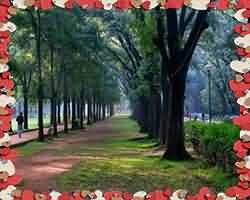 Cubbon Park
Cubbon Park
Laid out in 1864 by Richard Sankey, The chief engineer of Mysore, and named in honour of the Commissioner, Cubbon Park extends over an area of 135-ha (334 acres). Its partly formal landscaping imaginatively integrates natural rock out croppings with groves of trees and giant bamboos. The park is liberally dotted with statues, such as that of the 19th Century ruler Chamarajendra Wodeyar ( 1868 - 94 ) over looking the pond near an Octagonal, cast-iron bandstand. There are also marble statues of Queen Victoria and Edward VII. In the middle of the park a red painted, Neo-Classical building known as the Sheshadri Iyer Memorial Houses a Public Library.
The avenue of araucarias along with canna beds on either sides of the road from the Central Public Library to Hudson circle, avenue of Swieteninas in the Northern side of the park, the Java fig avenue along the road leading to the Government Museum, polyalthia avenue along the road from Queen’s statue to King Edward statue and the chestnut tree avenue from the Chamarajendra statue to Siddalingaiah circle are testimony to the botanical richness of the park. From the Attara Kacheri towards the East, terrace garden developed on a gradient provides a beautiful sight. Other attractions at the Park are the Ringwood circle, lotus pond and bamboo grove nook.

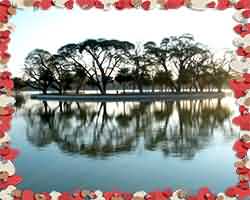 Ulsoor Lake
Ulsoor Lake
Halasuru Lake , one of the biggest lakes in Bengaluru, is located on the eastern side of the city. It derives its name from the name of the locality it is situated, namely, Ulsoor, close to M G Road, Bangalore. It is spread over 50 ha (123.6 acres)) and has several islands. Even though the lake is dated to Kempegowdas' time, the present lake was created by Sir Lewin Bentham Bowring, the then Commissioner of Bangalore. The lake was subject to several types of pollution threats.
There used to be a jackfruit orchard near the Ulsoor Lake, and the Kannada name for jackfruit being ‘Halasina Hannu’, the area came to be known as Halasuru. During the British rule, the name was anglicised to "Ulsoor".
There are several old temples in Ulsoor, which are scattered throughout the area. The oldest temple is the Halasuru Someshwara Temple, was built by Kempe Gowda in the 16th century and is a mixture of Hoysala, Chola and Vijayanagara architecture.

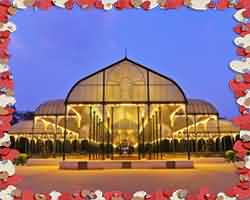 Lalbagh Botanical Garden
Lalbagh Botanical Garden
The Lalbagh Botanical Garden, Bangalore is of royal origin and was started initially as a private garden in an area of 40 acres by Hyder Ali, one of the most famous rulers of old Mysore in 1760. Initially designed in Mughal style, on the model of an extensive garden at Sira in Tumkur near Bangalore, this garden was further developed by Hyder Ali's son Tipu Sultan and subsequently by the British and Indian doyens of horticulture by extension of area and addition of a number of plant species. Lalbagh is currently under the aegis of the Directorate of Horticulture, Government of Karnataka. The Directorate is housed amidst the splendid environs of the botanical garden.
Lalbagh was given the status of a Government Botanical Garden in 1856, and since then, it has been an internationally renowned centre for scientific study of plants and botanical artwork and also conservation of plants. Formal and informal styles dominate the garden in perfect harmony, which is a testimony to the beauty of nature. Today, the garden is a lush green paradise with an area of 240 acres in the heart of the city.

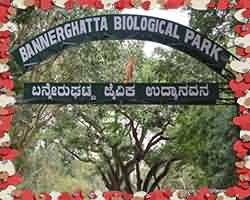 Bannerghatta National Park
Bannerghatta National Park
The Bannerghatta National Park is one of the richest natural zoological reserves present in India. Situated at a distance of 22 km south of Bangalore city, this 104.27 sq km park is a major tourist attraction in the state of Karnataka. Inside the park one can find a zoo which has a small museum, a reptile park and a theatre. Other than these, a Butterfly Park spread across an area of 30,000 sq m of land displays a unique combination of science and technology. Being the first of its kind in India, this man-made park in Bannerghatta National Park is a great source of knowledge, especially for children since it has a butterfly conservatory, an audio-visual room and a museum.
Typical tropical environment has been artificially created inside the butterfly park to carefully preserve over 20 different species of exquisite butterflies. Another major attraction of the park is the children's corner. Also trekking enthusiasts can enjoy trekking in the Uddigebande, Hajjamana Kallu and Mirza hills.

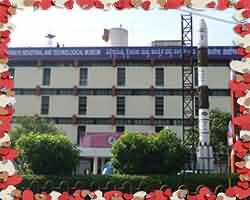 Visvesvaraya Industrial and Technological Museum
Visvesvaraya Industrial and Technological Museum
Visveswaraya Industrial and Technological Museum is situated on the Kasturba Road in Bangalore. Named after M. Visveswaraya, the Dewan of Mysore, it comprises of five galleries, namely Popular Science Gallery, Kimbe Paper Metals Gallery, Children's Science Gallery, Electronic Technology Gallery and Engine Hall Gallery. Visveswaraya Museum is the perfect place to get an idea about the working of different types of machines. Given below is more information on Visveswaraya Industrial and Technological Museum of Bangalore, India. Apart from airplane and steam engine, a number of other items are also on display inside the museum. For example, exhibits on electronics, motor power, uses and properties of wood and metal, etc.
If you have an interest in popular science, you can also work on some of the exhibits. A major attraction of the Visveswaraya Industrial and Technological Museum comprises of its mobile science exhibition.

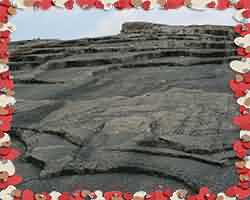 Peninsular Gneiss
Peninsular Gneiss
Peninsular Gneiss is a term coined to highlight the older gneissic complex of the metamorphics found all over the Indian Peninsula. This term was first fashioned by W.F.Smeeth of the Mysore Geological Department in 1916 based on the first scientific study of this rock exposure. The Geological Survey of India identified one of the best exposures of this rock mass, protruding high above the ground as a hillock (pictured), dated 2.5 to 3.4 billion years, in the Bangalore city in India at the famous Lalbagh gardens and declared it as a National Geological Monument to propagate the knowledge of the rock formation among the public, since Lalbagh is frequented by visitors from all over the world. It is also called the Lalbagh rock.
As general information, gneiss is a coarse - grained high grade metamorphic rock formed at high pressures and temperatures in which light and dark mineral constituents are segregated into visible bands.

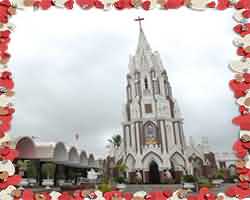 St. Mary's Basilica, Bangalore
St. Mary's Basilica, Bangalore
St. Mary's Basilica is a basilica located in the Archdiocese of Bangalore in the Indian state of Karnataka. It is the oldest church in Bangalore and is the only church in the state that has been elevated to the status of a minor basilica. It is famous for the festivities held during the St. Mary's Feast in the month of September each year, an event that attracts a number of devotees from in and around Bangalore.
The basilica has been built in the Gothic style with arches, ornamental motifs and stained glass windows. Multiple columns and the tall spires of the basilica can be seen from quite a distance. The stained glass windows were removed during World War II and were subsequently restored in 1947.
St. Mary's Feast which celebrates the birth of Mother Mary is the most important festival celebrated in the basilica and is attended by lakhs of people. Held in the month of September, the festivities go on for 10 days culminating in a grand chariot procession on the last day.
